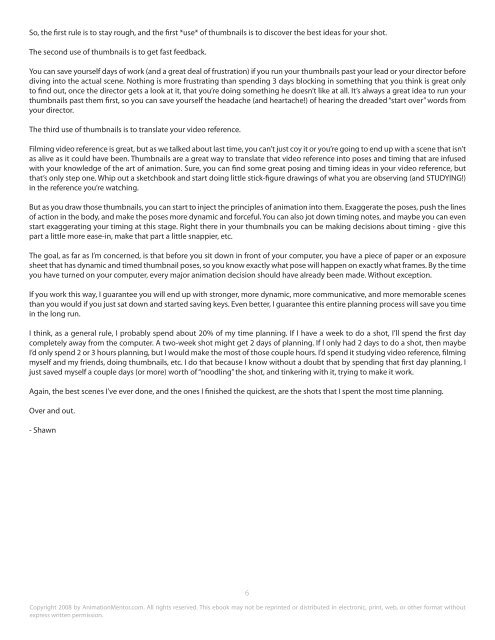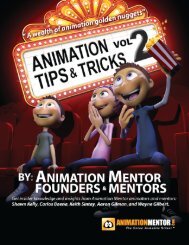THUMBNAILSWelcome back!This month we’re going to talk about thumbnails (and as promised, I’ll be more brief!). So, what are thumbnails? Well, animatorsoften use the fingernails on their thumbs to animate with. If you use your thumbnails to click your mouse buttons instead of yourforefingers, you get a much better result.Wow, was that the all-time worst animation joke in the history of animation jokes? I think it must be, though I’d also hazard a guessthat the “history of animation jokes” is probably pretty short.Okay, so - for real now - what the heck are thumbnails?Basically, “thumbnail” is a term used to describe a small “thumbnail-sized” drawing that describes a pose, an action, or an idea.The first rule of thumbnails is, don’t talk about thumbnails.Jeeeez. I just did it again. Second worst animation joke in the history of animation jokes. Sorry. It won’t happen again, I promise.Okay, the first rule of thumbnails is: LET THEM BE ROUGH.They are SUPPOSED to look rough. They are not meant to be pretty pictures. Don’t spend (waste!) a lot of time making each thumbnaillook like a piece of art. Don’t waste time shading it in, drawing all the little details, etc. They’re meant to be fast and sloppy. The entirepoint of doing thumbnails is that it saves you time.How does it save you time? Well, if you do thumbnails as part of your planning process, then you can work through all of your ideasBEFORE sitting down in front of the computer, and it’s inarguably much faster to doodle a little stick-man doing a pose than it is topose him out in the computer.We use thumbnails to work through our ideas. To get past our first ideas (remember - your first idea is always the worst and mostclichéd idea. The first idea you think of is probably the first and most obvious idea that the audience will think of too!), and get onto the ideas that count. The later ideas will be the good ones. They’ll be the most inventive ideas, and the most original. But to reachthose ideas, you’ll first have to work through the clichéd ideas, right? Thumbnails are, without a doubt, the fastest way to do that.The quickest road to a great idea, then, is through thumbnails!When you get a new scene, sit down and start doodling. Maybe it’s just poses. Maybe it’s working out full actions. Either way,you’re quickly discovering what will work and what won’t, and it’s all on paper. Quick and dirty - that’s the way to do it. Use a stickman,even. Many of the best animators do their thumbnails with what is essentially a stick-man. As long as you can see where thecharacter’s hips are, the angle of the hips, the angle of the shoulders, angle of the head, and the position of the limbs - that’s ALL youneed to know at this point, and you shouldn’t be worrying about any other details yet, generally speaking.5Copyright 2008 by <strong>Animation</strong><strong>Mentor</strong>.com. All rights reserved. This ebook may not be reprinted or distributed in electronic, print, web, or other format withoutexpress written permission.
So, the first rule is to stay rough, and the first *use* of thumbnails is to discover the best ideas for your shot.The second use of thumbnails is to get fast feedback.You can save yourself days of work (and a great deal of frustration) if you run your thumbnails past your lead or your director beforediving into the actual scene. Nothing is more frustrating than spending 3 days blocking in something that you think is great onlyto find out, once the director gets a look at it, that you’re doing something he doesn’t like at all. It’s always a great idea to run yourthumbnails past them first, so you can save yourself the headache (and heartache!) of hearing the dreaded “start over” words fromyour director.The third use of thumbnails is to translate your video reference.Filming video reference is great, but as we talked about last time, you can’t just coy it or you’re going to end up with a scene that isn’tas alive as it could have been. Thumbnails are a great way to translate that video reference into poses and timing that are infusedwith your knowledge of the art of animation. Sure, you can find some great posing and timing ideas in your video reference, butthat’s only step one. Whip out a sketchbook and start doing little stick-figure drawings of what you are observing (and STUDYING!)in the reference you’re watching.But as you draw those thumbnails, you can start to inject the principles of animation into them. Exaggerate the poses, push the linesof action in the body, and make the poses more dynamic and forceful. You can also jot down timing notes, and maybe you can evenstart exaggerating your timing at this stage. Right there in your thumbnails you can be making decisions about timing - give thispart a little more ease-in, make that part a little snappier, etc.The goal, as far as I’m concerned, is that before you sit down in front of your computer, you have a piece of paper or an exposuresheet that has dynamic and timed thumbnail poses, so you know exactly what pose will happen on exactly what frames. By the timeyou have turned on your computer, every major animation decision should have already been made. Without exception.If you work this way, I guarantee you will end up with stronger, more dynamic, more communicative, and more memorable scenesthan you would if you just sat down and started saving keys. Even better, I guarantee this entire planning process will save you timein the long run.I think, as a general rule, I probably spend about 20% of my time planning. If I have a week to do a shot, I’ll spend the first daycompletely away from the computer. A two-week shot might get 2 days of planning. If I only had 2 days to do a shot, then maybeI’d only spend 2 or 3 hours planning, but I would make the most of those couple hours. I’d spend it studying video reference, filmingmyself and my friends, doing thumbnails, etc. I do that because I know without a doubt that by spending that first day planning, Ijust saved myself a couple days (or more) worth of “noodling” the shot, and tinkering with it, trying to make it work.Again, the best scenes I’ve ever done, and the ones I finished the quickest, are the shots that I spent the most time planning.Over and out.- Shawn6Copyright 2008 by <strong>Animation</strong><strong>Mentor</strong>.com. All rights reserved. This ebook may not be reprinted or distributed in electronic, print, web, or other format withoutexpress written permission.
- Page 2 and 3: Animation Tips & TricksBY: Shawn Ke
- Page 4 and 5: INTRODUCTIONWelcome to the First Ed
- Page 6 and 7: FOUNDERS BIOSBobby BeckBobby was an
- Page 8 and 9: TESTIMONIALS“Three things come to
- Page 10 and 11: PLANNINGBecause this is the first a
- Page 12 and 13: REFERENCE MATERIALSWe've been talki
- Page 16 and 17: BLINKS HAVE MEANINGTip 1: Blinks Ha
- Page 18 and 19: Then a thought occurs to him: “is
- Page 20 and 21: has his shovel in hand. His eyes ar
- Page 22 and 23: THE FACEHey there animators! Welcom
- Page 24 and 25: OPERATIVE WORDSHello Animators!Welc
- Page 26 and 27: So, to make a long story short - ch
- Page 28 and 29: Well, for one thing, you want to sp
- Page 30 and 31: KEEP SECONDARY CHARACTERS SECONDARY
- Page 32 and 33: might glance at him to gauge his re
- Page 34 and 35: ACTINGHello Animators!Welcome back!
- Page 36 and 37: If you ignore the principles of act
- Page 38 and 39: Anyway, if the whole point of exagg
- Page 40 and 41: FORGET ABOUT THE LEGSHello animator
- Page 42 and 43: TRACK YOUR ARCSOkay, before I get s
- Page 44 and 45: it...Anyway, the hips move in a clo
- Page 46 and 47: TRACK YOUR ARCS - PART IIWell, gues
- Page 48 and 49: "Let's say my character is going to
- Page 50 and 51: But what's a love story without fir
- Page 52 and 53: cycle (say, a blink, or one hand ha
- Page 54 and 55: Step...Step...Punch. I had a big pr
- Page 56 and 57: after it. Once you choose your mome
- Page 58 and 59: incredibly easy to get so caught up
- Page 60 and 61: that's a toughie, but maybe you can
- Page 62 and 63: That's 40 years of inspiration. 40
- Page 64 and 65:
TWINNINGHello!Last month, we were s
- Page 66 and 67:
more organic, and far more interest
- Page 68 and 69:
The end result, of course, is a far
- Page 70 and 71:
BLACK OUT YOUR CHARACTEROk, so it's
- Page 72 and 73:
performance (particularly the eye a
- Page 74 and 75:
RISE ABOVE THE SNOBBERYOkay, here's
- Page 76 and 77:
Animation students live and work in
- Page 78 and 79:
MOVING FROM TRANFORMERS TO CARTOONS
- Page 80 and 81:
stylistically. Too fast here, dead
- Page 82 and 83:
HOW TO IMPRESS RECRUITERSHello ther
- Page 84 and 85:
ecruiter has no idea of your true a
- Page 86 and 87:
23TIPREVERSALSWell hello there!Last
- Page 88 and 89:
From #1 to #2, all you really need
- Page 90 and 91:
else we can decide that no, we don'
- Page 92 and 93:
IT AIN’T OVER TILL THE CHARACTERS
- Page 94 and 95:
project where the deadlines are too
- Page 96 and 97:
then. The first one will be next mo
- Page 98 and 99:
The computer will help you try to s








